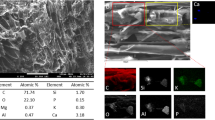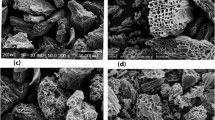Abstract
Delonix regia pods have been used to produce high-efficiency and low-cost activated carbons using different activation methods. The ability of these prepared sorbents to remove cations [137Cs, 85Sr, La(III), Eu(III), Co(II), U(VI)] and anions [75Se, Cr(VI), Mo(VI)] was evaluated in mono-component systems and the sorbents number 11, 13, 25, and 35 showed high removal efficiency. These sorbents also show the high ability to remove organic pollutants such as methylene blue and phenol. This study highlighted the extensive applicability of these low-cost sorbents in the sequestration of anionic and cationic radionuclides from real radioactive wastewaters and different environmental samples.









Similar content being viewed by others
References
Yakout SM, Hassan HS (2014) Adsorption characteristics of sol gel-derived zirconia for cesium ions from aqueous solutions. J Mol 19(7):9160–9172. https://doi.org/10.3390/molecules19079160
Hamed MM, Hilal MA, Borai EH (2016) Chemical distribution of hazardous natural radionuclides during monazite mineral processing. J Environ Radioact 162–163:166–171. https://doi.org/10.1016/j.jenvrad.2016.05.028
El-Sayed AA, Hamed MM, El-Reefy SA (2010) Determination of micro amounts of zirconium in mixed aqueous organic medium by normal and first derivative spectrophotometry. J Anal Chem 65:1113–1117. https://doi.org/10.1134/S1061934810110043
Gad HMH, Hamed MM, Abo Eldahab HMM, Moustafa ME, El-Reefy SA (2017) Radiation-induced grafting copolymerization of resin onto the surface of silica extracted from rice husk ash for adsorption of gadolinium. J Mol Liq 231:45–55. https://doi.org/10.1016/j.molliq.2017.01.088
Hamed MM (2014) Sorbent extraction behavior of a nonionic surfactant, Triton X-100, onto commercial charcoal from low level radioactive waste. J Radioannal Nucl Chem 302:303–313
Tiryaki B, Yagmur E, Banford A, Aktas Z (2014) Comparison of activated carbon produced from natural of biomass and equivalent chemical composition. J Anal Appl Pyrol 105:276–283. https://doi.org/10.1016/j.jaap.2013.11.014
Yakout SM, Hamed MM, Hassan HS (2012) Solid phase extraction of nitrate and nitrite anions using naturallyand available sorbent. J Radioannal Nucl Chem 295:697–708. https://doi.org/10.1007/s10967-012-1896-6
El-Sayed AA, Hamed MM, Hmmad HA, El-Reefy SA (2007) Collection/concentration of trace uranium for spectrophotometric detection using activated carbon and first-derivative spectrophotometry. Radiochim Acta 95:43–48. https://doi.org/10.1524/ract.2007.95.1.43
Tan IAW, Ahamad AL, Hameed BH (2008) Adsorption of basic due on high surface area activated carbon prepared from coconut husk: equilibrium, kinetic and thermodynamic studies. J Hazard Mater 154(1–3):337–346. https://doi.org/10.1016/j.jhazmat.2007.10.031
Zhao XT, Zeng T, Hu ZJ, Gao HW, Zou CY (2012) Modeling and mechanism of the adsorption of proton onto natural bamboo sawdust. Carbohydr Polym 87(2):1199–1205. https://doi.org/10.1016/j.carbpol.2011.08.098
Rizk HE, Hamed MM, Ahmed IM (2018) Adsorption behavior of zirconium and molybdenum from nitric acid medium using low-cost adsorbent. J Mol Liq 249:361–370. https://doi.org/10.1016/j.molliq.2017.11.049
Zhao XT, Zeng T, Li XY, Hu ZJ, Gao HW, Xie Z (2012) Modeling and mechanism of the adsorption of copper ion onto natural bamboo sawdust. Carbohydr Polym 89(1):185–192. https://doi.org/10.1016/j.carbpol.2012.02.069
Angelina M, Thanga A, Rajagopal K (2015) Fluoride removal study using pyrolyzed Delonixregia pod, an unconventional adsorbent. Int J Environ Sci Technol 12:223–236. https://doi.org/10.1007/s13762-013-0485-8
Hosain L (2011) Ph.D. thesis, Ain Shams University, Cairo, Egypt
Mckay G (1996) Use of adsorbent for the removal of pollutants from wastewaters. CRC Press, New York
Yakout SM (2006) Treatment of waste effluents using active carbon prepared from Agro-residues. Ph.D. thesis, Ain Shams University, Egypt
Itodo AU, Abdulrahman FW, Hassan LG, Maigandi SA, Itodo HU (2010) Application of methylene blue and iodine adsorption in the measurement of specific surface area by four acid and salt treated activated carbons. J New York Sci 3(5):25–33
Bouchelta C, Medjram MS, Bertrand O, Bellat JP (2008) Preparation and characterization of activated carbon from date stones by physical activation with steam. J Anal Appl Pyrolysis 82:70–77. https://doi.org/10.1016/j.jaap.2007.12.009
Byamba-Ochir N, Shim WG, Balathanigaimani M, Moon H (2016) Highly porous activated carbons prepared from carbon rich Mongolian anthracite by direct NaOH activation. J Appl Surf Sci 379:331–337. https://doi.org/10.1016/j.apsusc.2016.04.082
Pallarés J, González-Cencerrado A, Arauzo I (2018) Production and characterization of activated carbon from barley straw by physical activation with carbon dioxide and steam. Biomass Bioenergy 115:64–73. https://doi.org/10.1016/j.biombioe.2018.04.015
Yahya MA, Al-Qodah Z, Ngah CZ (2015) Agricultural bio-waste materials as potential sustainable precursors used for activated carbon production: a review. Renew Sustain Energy Rev 46:218–235. https://doi.org/10.1016/j.rser.2015.02.051
Njoku V, Foo K, Asif M, Hameed B (2014) Preparation of activated carbons from rambutan (Nepheliumlappaceum) peel by microwave-induced KOH activation for acid yellow17dye adsorption. J Chem Eng 250:198–204. https://doi.org/10.1016/j.cej.2014.03.115
Samsuri A, Sadegh-Zadeh F, Seh-Bardan B (2014) Characterization of biochars produced from oil palm and rice husks and their adsorption capacities for heavy metals. Int J Environ Sci Technol 11:967–976. https://doi.org/10.1007/s13762-013-0291-3
Gratuito MKB, Panyathanmaporn T, Chumnanklang RA et al (2008) Production of activated carbon from coconut shell: optimization using response surface methodology. Bioresour Technol 99:4887–4895. https://doi.org/10.1016/j.biortech.2007.09.042
Cui X, Jia F, Chen Y, Gan J (2011) Influence of single-walled carbon nanotubes on microbial availability of phenanthrene in sediment. Ecotoxicology 20:1277–1285. https://doi.org/10.1007/s10646-011-0684-3
Wang B, Zhu C, Zhang Z et al (2016) Facile, low-cost, and sustainable preparation of hierarchical porous carbons from ion exchange resin: an improved potassium activation strategy. J Fuel 179:274–280. https://doi.org/10.1016/j.fuel.2016.03.088
Rambabu N, Rao B, Surisetty V et al (2015) Production, characterization, and evaluation of activated carbons from de-oiled canolameal for environmental applications. Ind Crops Prod 65:572–581. https://doi.org/10.1016/j.indcrop.2014.09.046
Hassler JW (1963) Active carbon. Chemical Publishing Company, New York
Fu K, Yue Q, Gao B, Wang Y, Li Q (2017) Activated carbon from tomato stem by chemical activation with FeCl2. Colloids Surf A Physicochem Eng Asp 529:842–849. https://doi.org/10.1016/j.colsurfa.2017.06.064
Xu Z, Sun Z, Zhou Y, Chen W, Zhang T, Huang Y, Zhang D (2019) Insights into the pyrolysis behavior and adsorption properties of activated carbon from waste cotton textiles by FeCl3-activation. Colloids Surf A Physicochem Eng Asp 582:123934. https://doi.org/10.1016/j.colsurfa.2019.123934
Cazetta AL, Pezoti O, Bedin KC, Silva TL, Paesano Junior A, Asefa T, Almeida VC (2016) Magnetic activated carbon derived from biomass waste by concurrent synthesis: efficient adsorbent for toxic dyes. ACS Sustain Chem Eng 4:1058–1068. https://doi.org/10.1021/acssuschemeng.5b01141
Deng H, Zhang G, Xu X, Tao G, Dai J (2010) Optimization of preparation of activated carbon from cotton satalks by microwave assisted phosphoric acid-chemical activation. J Hazard Mater 182:217–224. https://doi.org/10.1016/j.jhazmat.2010.06.018
Yang J, Zhao Y, Ma S, Zhu B, Zhang J, Zheng C (2016) Mercury removal by magnetic biochar derived from simultaneous activation and magnetization of sawdust. Environ Sci Technol 50:12040–12047. https://doi.org/10.1021/acs.est.6b03743
Ömer S, Cafer S (2013) Preparation and characterization of activated carbon from acorn shell by physical activation with H2O–CO2 in two-step pretreatment. Biores Technol 136:163–168. https://doi.org/10.1016/j.biortech.2013.02.074
Jin Z, Zhao G (2014) Porosity evolution of activated carbon fiber prepared from liquefied wood. Part II: water steam activation from 850 to 950°C. BioResources 9(4):6831–6840. https://doi.org/10.15376/biores.9.2.2237-2247
Lorenc-Grabowska E, Diez MA, Gryglewicz G (2016) Influence of pore size distribution on the adsorption of phenol on PET-based activated carbons. J Colloid Interface Sci 469:205–212. https://doi.org/10.1016/j.jcis.2016.02.007
Gokce Y, Aktas Z (2014) Nitric acid modification of activated carbon produced from waste tea and adsorption of methylene blue and phenol. Appl Surf Sci 313:352–359. https://doi.org/10.1016/j.apsusc.2014.05.214
Hamed MM, Holiel M, El-Aryan YF (2017) Removal of selenium and iodine radionuclides from waste solutions using synthetic inorganic ion exchanger. J Mol Liq 242:722–731. https://doi.org/10.1016/j.molliq.2017.07.035
Rizk SE, Hamed MM (2015) Batch sorption of iron complex dye, naphthol green B, from wastewater oncharcoal, kaolinite, and tafla. Desalin Water Treat 56:1536–1546. https://doi.org/10.1080/19443994.2014.954004
Caccin M, Giacobbo F, Da Ros M, Besozzi L, Mariani M (2013) Adsorption of uranium, cesium and strontium onto coconut shell activated carbon. J Radioannal Nucl Chem 297:9–18. https://doi.org/10.1007/s10967-012-2305-x
Khandaker S, KubaT KamidaS, Uchikawa Y (2017) Adsorption of cesium from aqueous solution by raw and concentrated nitric acid-modified bamboo charcoal. J Environ Chem Eng 5:1456–1464. https://doi.org/10.1016/j.jece.2017.02.014
Orhan Y, Buyukgungur H (1993) The removal of heavy metals by using agricultural wastes. Water Sci Technol 28:247–255. https://doi.org/10.2166/wst.1993.0114
Rovira M, Giménez J, Martínez M, Martínez-Lladó X, de Pablo J, Martí V (2008) Sorption of selenium(IV) and selenium(VI) onto natural iron oxides: goethite and hematite. J Hazard Mater 150:279–284. https://doi.org/10.1016/j.jhazmat.2007.04.098
Mary Gladis J, Prasada Rao T (2002) Anal Lett 35:501
Choi JH, Kim SD, Kwon YJ, Kim WJ (2006) Microporous Mesoporous Mater 96:157–167
Sepehriana H, Cheraghalib R, Rezaeib P, Abdi HA (2011) Int J Ind Chem 2(4):235–241
Namasivayam C, Sangeetha D (2006) Recycling of agricultural solid waste, coir pith: removal of anions, heavy metals, organics and dyes from water by adsorption onto ZnCl2 activated coir pith carbon. J Hazard Mater B 135:449–452. https://doi.org/10.1016/j.jhazmat.2005.11.066
Holiel M, Hamed MM, Ismail ZH (2016) Removal of 134Cs and 152+154Eu from liquid radioactive waste using Dowex HCR-S/S. Radiochim Acta 104:399–413. https://doi.org/10.1515/ract-2015-2514
Hamed MM, Attallah MF, Metwally SS (2014) Simultaneous solid phase extraction of cobalt, strontium and cesium from liquid radioactive waste using microcrystalline naphthalene. Radiochim Acta 102:1017–1024. https://doi.org/10.1515/ract-2013-2200
Ahmed IM, Aglan RF, Hamed MM (2017) Removal of Arsenazo-III and Thorin from radioactive waste solutions by adsorption onto low-cost adsorbent. J Radioannal Nucl Chem 314:2253–2262. https://doi.org/10.1007/s10967-019-06669-5
Author information
Authors and Affiliations
Corresponding author
Additional information
Publisher's Note
Springer Nature remains neutral with regard to jurisdictional claims in published maps and institutional affiliations.
Rights and permissions
About this article
Cite this article
Elgazzar, A.H., Ali, M.M.S., El-Sayed, A.A. et al. Preparation of various sorbents from agro waste to remove some radionuclides and organic species from aqueous solutions. J Radioanal Nucl Chem 326, 1733–1748 (2020). https://doi.org/10.1007/s10967-020-07476-z
Received:
Accepted:
Published:
Issue Date:
DOI: https://doi.org/10.1007/s10967-020-07476-z




